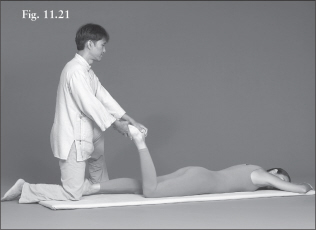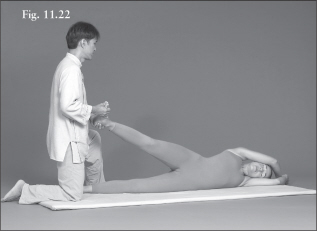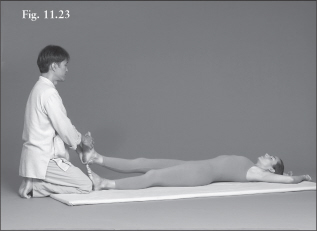
Back Postures
In our high-speed, fast-paced culture, aggravated vata is often expressed in the form of back pain and tension. Many individuals go about their daily activities carrying a back full of tense muscles that only massage practitioners can relieve.
According to Ayurveda, the spinal column is the main pathway of energy in the body and the place where unresolved emotions and experiences are stored. By working through tensions in the spine we release energy and allow that energy to flow freely from the coccyx all the way to the crown of the head, the seat of spiritual awareness.
At this point in the Thai Yoga Massage session many recipients will be deeply relaxed; some may even be close to falling asleep. You might want to have towels or small pillows available to tuck under the ankles, upper chest, and lower abdomen, all for the purpose of relaxing the lower back. Placing a pillow under the forehead will keep the nose from being pushed into the floor. When the recipient’s head is turned to one side, ask her to periodically move her head to the other side to avoid stiffness in the neck.
For the basic massage you will perform Sole Roll and Janu Pump on each leg before continuing with the remaining back postures. For the extended version, perform the first three exercises on the first leg and then on the second leg before moving on to the remaining back postures. When working on pregnant women, this section of the massage must be modified; from the second trimester on, a pregnant woman should not lie flat on her back for too long. The uterus and the baby are heavy in the abdomen and will compress the vena cava, the main vein at the back of the abdomen, decreasing the return of blood to the heart and thereby decreasing a woman’s blood pressure. A decrease in blood pressure will reduce the amount of blood and oxygen going to the baby. Pregnant women often instinctively shift to their side, which provides a more suitable posture for working on their backs. Variations such as Back Pedal or Standing Side Arc offer an excellent alternative for massaging the back in a side-lying posture.
Be careful not to overstretch your pregnant clients and do not perform inverted postures with them. Finally, do not apply pressure to the uterus or marma points.
Sole Roll V↓↓↓ P↓↓ K↓↓
Sit in Open Diamond stance alongside your recipient’s lower leg. Lift her left foot to rest on your right thigh (fig. 11.1).
Cup the recipient’s Achilles tendon with your left hand and roll into her sole with your right forearm (fig. 11.2). Gradually work toward the toes, then roll back to the heel.
Switch arms and use your left forearm to roll upward on the recipient’s calf (fig. 11.3).
Benefits: Compresses the intrinsic muscles of the foot; relieves tension and stiffness in the feet; relieves plantar fasciitis; provides a pressure point massage, toning the lungs.
Vayus activated: Prana
Ayurvedic tip: For bony vata recipients, be sure to create soft support with pillows or cushions. This exercise diffuses pitta irritability and aggression and relieves kapha congestion.
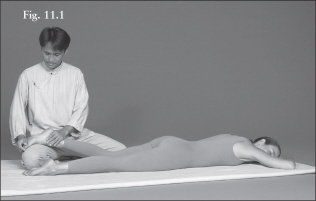
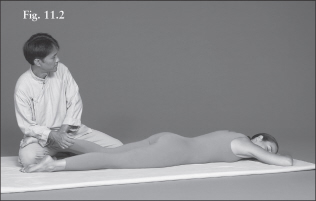
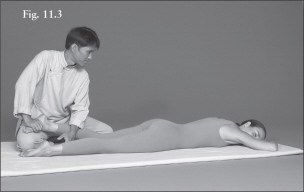
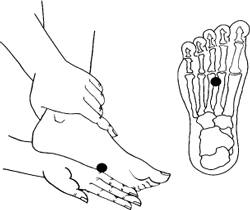
Talahridaya Marma
This marma point is situated at the upper center of the sole in line with the third toe. It is also located at the center of the palm in line with the third finger. Talahridaya marma stimulates the lungs and respiratory system.
Use your elbow to compress the Talahridaya marma for three to five breaths.
Remain in Open Diamond stance alongside the recipient, aligning the midline of your torso with the recipient’s left knee. Hold her left foot with your right hand and place your left fist into the back of the recipient’s knee so that your knuckles are facing the recipient’s midline (fig. 11.4).
Gradually fold the recipient’s foot in toward her buttock, applying pressure into the Janu marma point behind the knee (fig. 11.5). Hold for three breaths.
Repeat Janu Pump three times. Move with caution, as the back of the knee is a tender area.
For the basic massage, repeat the Sole Roll and Janu Pump on the right leg. For the extended version, include Frog posture on the right side before switching sides. When you’ve completed Frog posture on the right leg, perform the rest of the back postures bilaterally.
Benefits: Stimulates Janu marma, toning the heart, liver, and spleen; stretches the knee and flexes the hamstring, relieving leg fatigue; increases blood circulation in the legs, flushing away wastes and toxins.
Precautions: Do not apply pressure to Janu marma with the leg extended, as this causes excessive pressure on the knee.
Vayus activated: Samana, prana
Ayurvedic tip: The Janu marma is a major pitta point that releases tension from the heart and liver, both pitta organs. Hold this cooling posture longest for pittas.
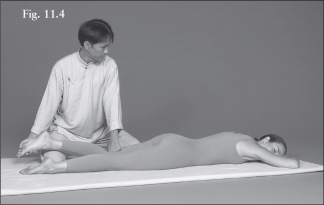
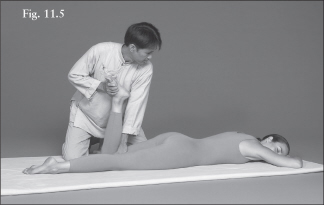
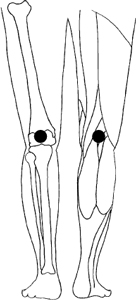
Janu Marma
This marma point has a front and back location; the front point is situated at the root of the knee and the back point is located behind the kneecap. Applying pressure to Janu marma helps to tone the heart, liver, and spleen. It also lubricates the joints and improves leg circulation.
Janu marma is stimulated during the Janu Pump exercise.
From Janu Pump, lift your left knee into Warrior stance and turn to face the recipient’s head. Cup the recipient’s left knee with your left hand and the foot with your right hand (fig. 11.6). Glide her knee forward to form a 90-degree angle between the foreleg and the thigh (fig. 11.7).
Wag your right leg inward and sit down. Place the blade of your left foot behind the recipient’s left knee (fig. 11.8). Lift her foot and tuck her toes behind your left knee, interlacing your lower legs together. Now place the ball of your right foot at the back of the recipient’s thigh; place your left hand onto the recipient’s left calf, and your right hand on her extended leg. Now gently extend your right leg and use the ball of your foot to walk up and down the thigh three to five times (fig. 11.9).
To release, cross your legs and sit up in Kneeling Diamond stance. Extend the recipient’s leg into a relaxed position.
Repeat Sole Roll, Janu Pump, and Frog on the right leg.
Benefits: Opens the hip joint and tractions the knee; promotes circulation to the legs; releases tension in the buttocks and lower back; relieves constipation.
Precaution: When you press in with your heel beware that you do not pinch the skin along the mat. Do not perform this movement on pregnant women or on any recipient who has had hip surgery.
Vayus activated: Vyana, samana
Ayurvedic tip: You can modulate the massage approach here by adjusting your distance from the recipient. Sitting further back from your recipient creates a softer pressure that is best for vatas; sitting closer creates a more intense pressure that benefits pittas and kaphas.
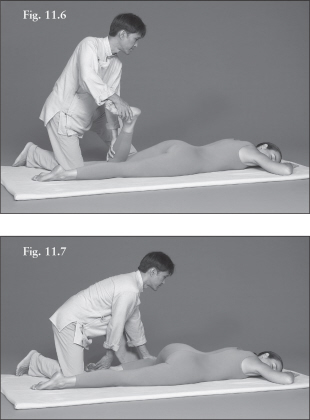
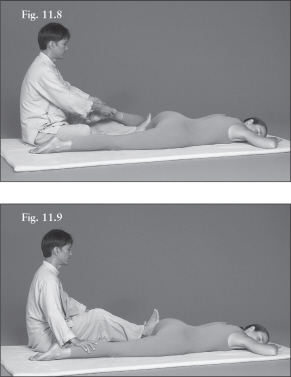
Sit in Diamond stance at the recipient’s feet so that your thighs are under her feet (fig. 11.10).
Lift the recipient’s lower legs to a 90-degree angle while you step your left knee up into Warrior stance (fig. 11.11).
Cross the recipient’s feet and place your hands on them. Glide your Warrior forward, fall in with the full weight of your body, and press the recipient’s feet toward her buttocks (fig. 11.12). Keep your arms and back straight and hold for three to five breaths. Release back to the 90-degree angle. Repeat two times.
Cross the recipient’s feet with the other foot on top and perform Reverse Lotus three times. To release, hold onto the recipient’s feet as you knee-walk back and straighten her legs.
Adaptation: Place a pillow between the buttocks and feet if your recipient is very stiff or has knee problems.
Benefits: Increases flexibility of the feet; stretches the hamstrings and iliotibial band.
Precautions: Proceed with extreme care in cases of knee injury or lower back pain.
Vayus activated: Samana, apana
Ayurvedic tip: This bound posture, cooling in its effects, is especially good for pittas. It also helps promote a consistent agni, or digestive fire.
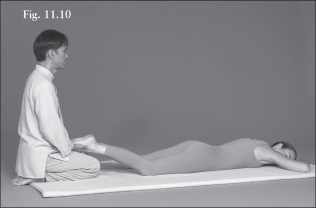
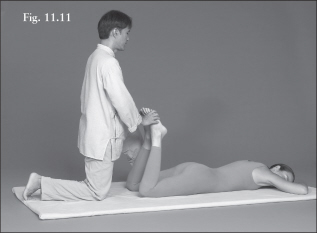
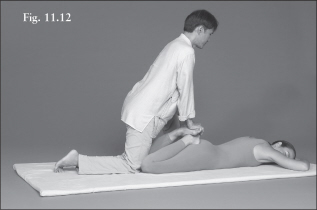
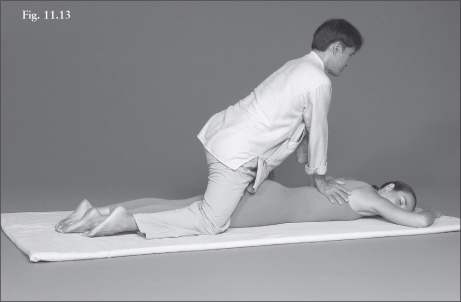
Straddle the recipient in Warrior stance. With arms and back straight, palm up and down the back on either side of the spine (fig. 11.13).
Use the full weight of your body to press into the recipient’s spinal muscles. Synchronize your breath as you forward rock, encouraging the dance of Thai Yoga Massage to emerge.
Benefits: Works on the paravertebral muscles and autonomic nervous system; relieves back stress and muscle spasms; stimulates the internal organs; aligns the spine.
Precaution: Be careful not to put pressure directly on the spine. Move the recipient’s head from side to side every few minutes to prevent stiffness in the neck.
Vayus activated: Vyana, samana
Ayurvedic tip: Follow the appropriate sen-line approach for each dosha. Vatas require a slow and meditative rhythm with an approximate three-second pause before alternating palms; pittas benefit from a cooling and moderate pace with a two-second pause; and kaphas require a more aerobic approach with a one-second pause. For more details on approaches to sen-line work see chapter 6.
This stronger version of Palming Back can be useful for practitioners with weak or sore wrists. It can also be used in place of palming the back when you want to apply stronger pressure. However, this is a very powerful posture, so you must be gradual in applying your weight to the recipient’s back muscles. Never apply more than twenty percent of your full strength.
From Palming Back, position yourself to the left side of the recipient in Kneeling Diamond stance.
Place your left hand on the recipient’s left scapula and your right hand on the right side of her sacrum. Lift your right knee and apply gradual pressure to the left buttocks (fig. 11.14). Move up along the paravertebral muscles on the left side of the body as far as you are comfortable and stable (fig. 11.15).
Move up and down the back three times.
Benefits: Works on the paravertebral muscles and autonomic nervous system; relieves back stress and muscle spasms; stimulates the internal organs; aligns the spine.
Precaution: Ask for feedback from your recipient, closely monitoring her or his comfort level. Never knee directly on the spine. Avoid this posture when working on the elderly.
Vayus activated: Vyana, samana
Ayurvedic tip: This strong sen-line variation is most suitable for kaphas.
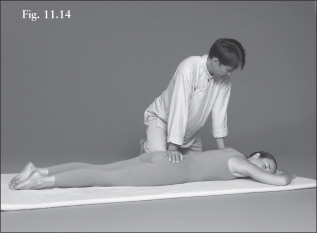
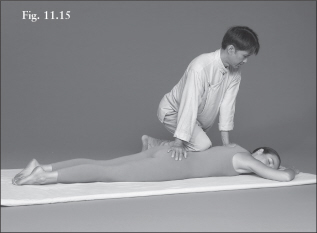
Place a pillow on the recipient’s lower back. Gently sit on the recipient’s upper sacrum, your feet flat on the floor (fig. 11.16).
Place the recipient’s arms across your thighs, her hands hanging to the side. Grasp the recipient’s shoulders from above (fig. 11.17).
Using directed breathing, ask the recipient to inhale deeply, then exhale. On the exhale, lean back, leveraging your weight to lift the recipient into a backbend (fig. 11.18).
Release by gently returning the recipient’s chest to the mat. Ask that the recipient turn her head to the side as the upper body comes back down to the mat.
Benefits: Flexes the spine; opens the chest; relieves lower back ache and spinal stiffness; restricts blood flow to the femoral artery, clearing the blood vessels and promoting circulation.
Precaution: Avoid jerky movements.
Common mistake: The practitioner’s feet are too close together, causing instability in the posture.
Vayus activated: Prana, vyana, samana
Ayurvedic tip: This is the most stable, easy-to-perform Cobra and is good for all body types.
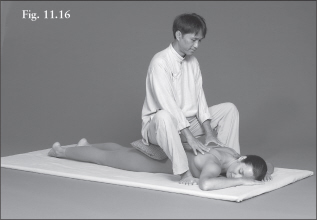
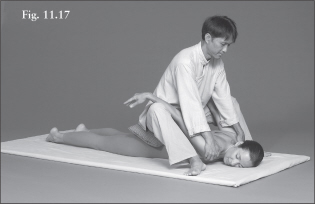
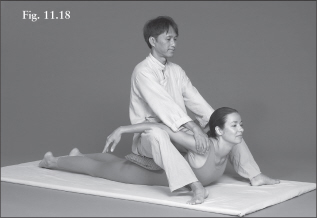
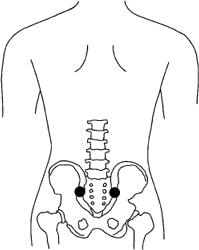
Kukundara Marma
This point is located on either side of the sacrum, just above the fleshy part of the buttocks. Kukundara marma governs blood formation and menstruation.
Kukundara marma is stimulated by Pillow Cobra pose.
Classical Cobra V↓↓ P↓↓ K↓↓↓
From the sen work on the back move into Kneeling Diamond stance, with your knees fixed on the recipient’s buttocks. Ask the recipient to hold onto your wrists or forearms (fig. 11.19).
Using directed breathing, ask the recipient to inhale deeply, then exhale. On the exhale lean backward, using the leverage of the movement to gently pull the recipient into a backbend (fig. 11.20).
Release by coming back into an upright kneeling position, gently returning the recipient to the mat.
Benefits: Flexes the spine; provides traction through the shoulder girdle, stretching the deltoid muscles; opens the chest; stimulates the internal organs; aids digestion; promotes flexibility of the spine; relieves lower back ache and spinal stiffness; relieves nasal congestion.
Precaution: Avoid performing this posture with recipients who have suffered a dislocated shoulder in the past.
Common mistake: The practitioner’s grip of the wrist or forearm is not secure. The knees are not firmly positioned on the buttocks. Be sure to position yourself strongly and securely before performing this posture.
Vayus activated: Vyana, prana, samana
Ayurvedic tip: This chest opener is great for releasing excess kapha. Very fiery pittas can exhale through the mouth or use some of the cooling breathing techniques discussed on page 79 to prevent overheating in this pose.
Place the recipient’s arms above her head, palms facing down. Come into Warrior stance at the recipient’s feet. Grasp the recipient’s right foot with your right hand and cup her heel with your left hand (fig. 11.21). Extend the right leg, and then gently rotate the recipient toward the medial side to bring her into the supine position (figs. 11.22 and 11.23).
This is a fun and effortless way to turn the
recipient over. Just remember that most of the rotation occurs at the hip—you will master it in no time! Do not perform this transition on recipients with a history of hip or ankle conditions, such as arthritis, osteoporosis, or replacement joints. Ask those recipients to turn over on their own.
This is the end of the back postures. We’re now ready to move on to the double-leg postures.
